mirror CHEVROLET CAMARO 1994 4.G Owners Manual
[x] Cancel search | Manufacturer: CHEVROLET, Model Year: 1994, Model line: CAMARO, Model: CHEVROLET CAMARO 1994 4.GPages: 292, PDF Size: 15.35 MB
Page 47 of 292
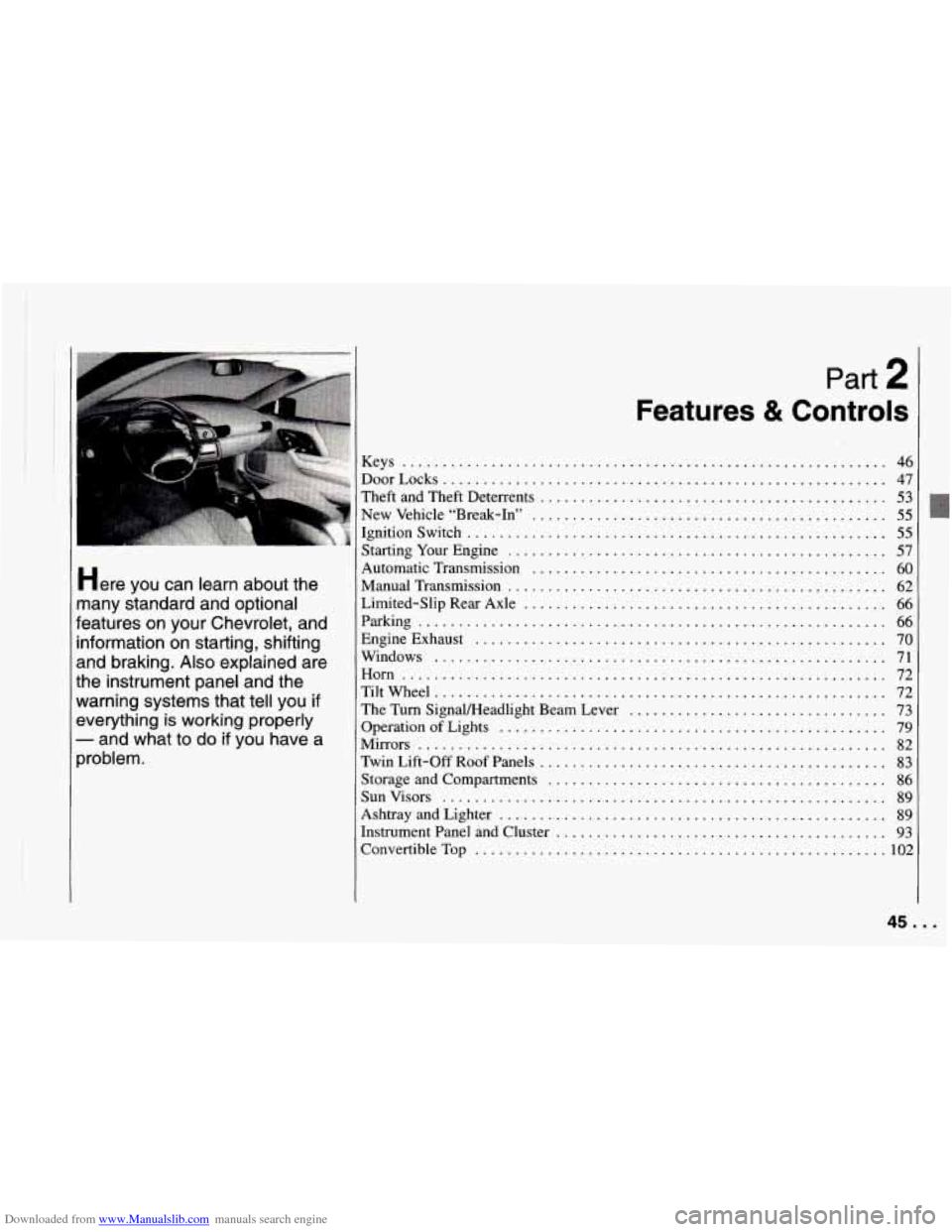
Downloaded from www.Manualslib.com manuals search engine Here you can learn about the
nany standard and optional
eatures on your Chevrolet. and
nformation
on starting. shifting
md braking
. Also explained are
he instrument panel and the
varning systems that tell you
if
tverything is working properly
- and what to do if you have a
)roblem .
.
... ........ Part 2
Features & Contro
Keys ............................................................
DoorLocks .......................................................
Theft and Theft Deterrents ...........................................
New Vehicle “Break-In” ............................................
Ignitionswitch ....................................................
StartingYourEngine ...............................................
Automatic Transmission ............................................
ManualTransmission ...............................................
Limited-Slip Rear Axle .............................................
Parking ..........................................................
EngineExhaust ...................................................
Windows ........................................................
Horn ............................................................
TiltWheel ........................................................
OperationofLights ................................................
Mirrors ..........................................................
Twin Lift-off Roof Panels ...........................................
Storage and Compartments ..........................................
Sunvisors .......................................................
Ashtray and Lighter ................................................
Instrument Panel and Cluster .........................................
ConvertibleTop ...................................................
The Turn Signameadlight Beam Lever ................................
S
46
47
53
55
55
57 60
62
66
66
70
71
72
72
73
79
82
83
86
89
89
93
102
45 ...
Page 58 of 292
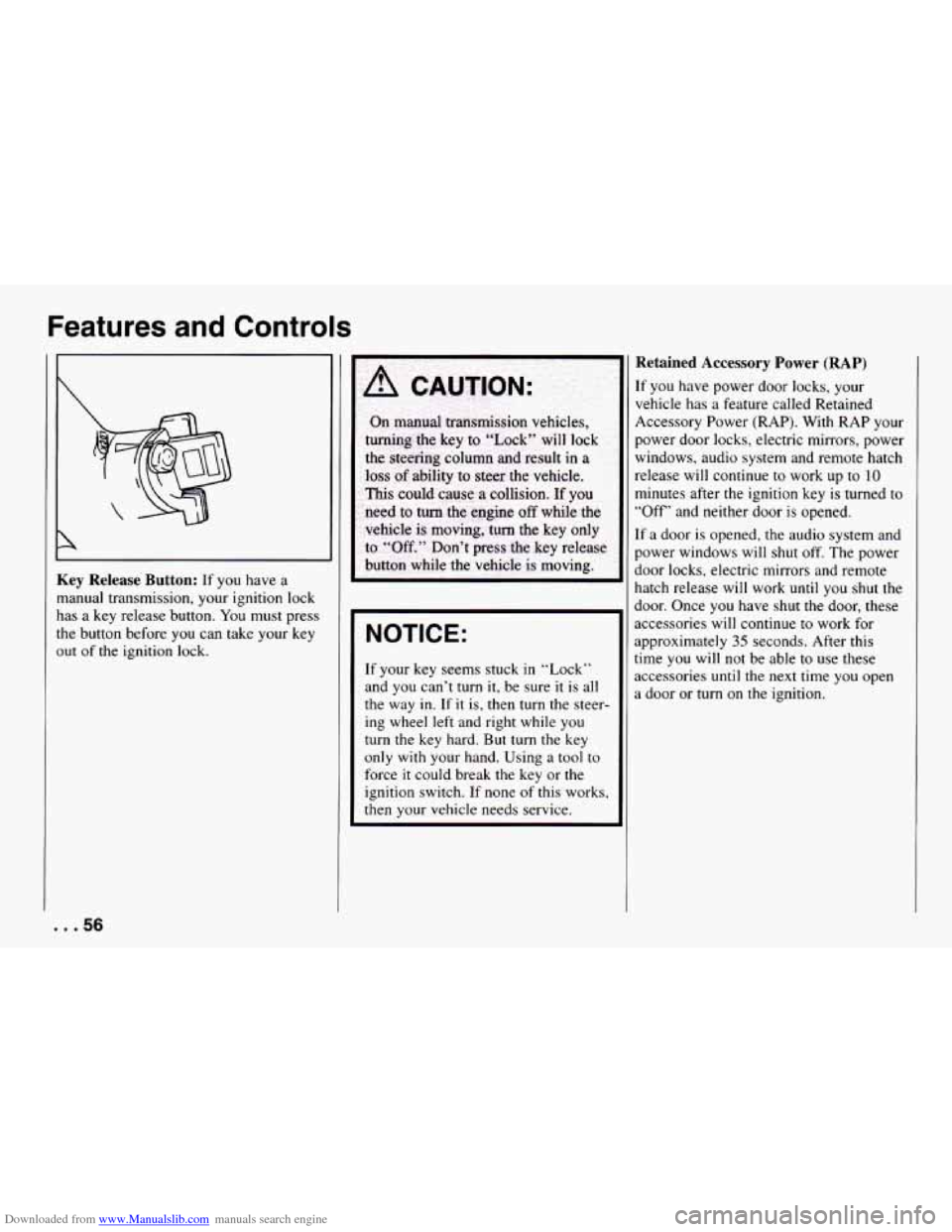
Downloaded from www.Manualslib.com manuals search engine Features and Controls
Key Release Button: If you have a
manual transmission, your ignition lock
has a key release button.
You must press
the button before
you can take your key
out
of the ignition lock.
NOTICE:
If your key seems stuck in “Lock”
and you can’t turn
it, be sure it is all
the way in. If it is, then turn the steer-
ing wheel left and right while you
turn the key hard. But turn the key
only with your hand. Using
a tool to
force it could break the key or the
ignition switch. If none
of this works,
then
your vehicle needs service.
Retained Accessory Power (RAP)
If you have power door locks, your
vehicle has a feature called Retained
Accessory Power (RAP). With RAP your
power door locks, electric mirrors, power
windows, audio system and remote hatch
release
will continue to work up to 10
minutes after the ignition key is turned to
“Off’ and neither door
is opened.
If
a door is opened, the audio system and
power windows will shut off. The power
door locks, electric mirrors and remote
hatch release
will work until you shut the
door. Once you have shut the door, these
accessories
will continue to work for
approximately
35 seconds. After this
time you will not be able to use these
accessories until the next time you open
a door or
turn on the ignition.
... 56
Page 83 of 292
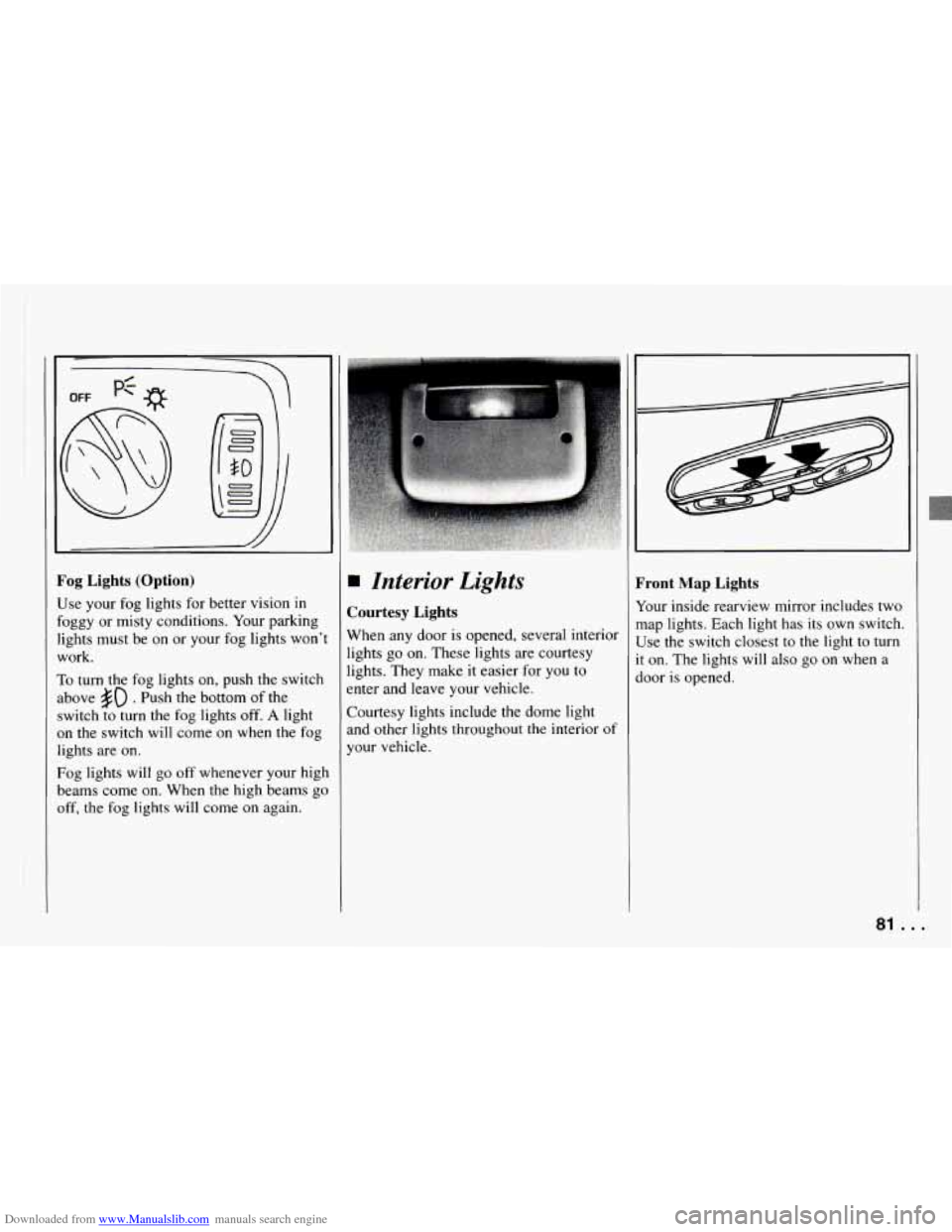
Downloaded from www.Manualslib.com manuals search engine \
?og Lights (Option)
Jse your fog lights for better vision in
oggy or misty conditions. Your parking
ights must be on or your fog lights won7
work.
To turn the fog lights on, push the switch
tbove
$0 . Push the bottom of the
;witch to turn the fog lights off.
A light
In the switch will come on when the fog
ights are on.
Zog lights
will go off whenever your higl
>earns come
on. When the high beams gc
Iff, the fog lights will come on again.
I Interior Lights
ourtesy Lights
Then any door is opened, several interior
ghts go on. These lights are courtesy
ghts. They make it easier for you to
Iter and leave your vehicle.
ourtesy lights include the dome light
Id other lights throughout the interior of
)ur vehicle.
kont Map Lights
Tour inside rearview mirror includes two
nap lights. Each light has its own switch.
Jse the switch closest to the light to turn
t on. The lights will also go on when a
loor is opened.
81 ...
Page 84 of 292
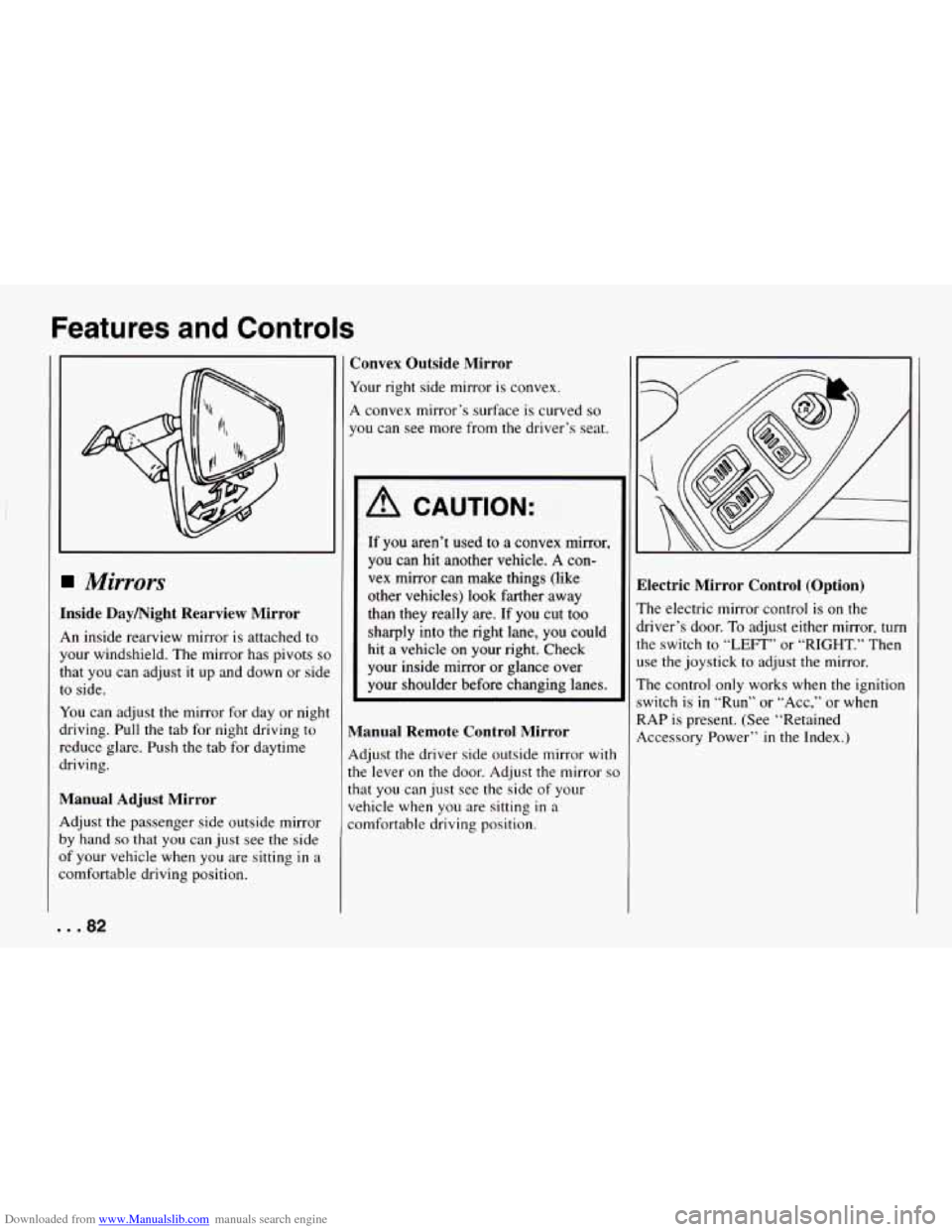
Downloaded from www.Manualslib.com manuals search engine Features and Controls
Mirrors
Inside Daymight Rearview Mirror
An inside rearview mirror is attached to
your windshield. The mirror has pivots
so
that you can adjust it up and down or side
to side.
You can adjust the mirror for day or night
driving.
Pull the tab for night driving to
reduce glare. Push the tab for daytime
driving.
Manual Adjust Mirror
Adjust the passenger side outside mirror
by hand so that you can just see the side
of your vehicle when you are sitting in a
comfortable driving position.
Convex Outside Mirror
Your right side mirror is convex.
A convex mirror’s surface is curved
so
you can see more from the driver’s seat.
L%, CAUTION:
If you aren’t used to a convex mi1
you can hit another vehicle. A cor
vex mirror can make things (like
other vehicles) look farther away
than they really are. If you cut toc
sharply into the right lane, you co
hit a vehicle on your right. Check
your inside mirror or glance over
your shoulder before changing lar
Manual Remote Control Mirror
Adjust the driver side outside mirror with
the lever on the door. Adjust the mirror
so
that you can just see the side of your
vehicle when you are sitting
in a
comfortable driving position.
Tor, 1
1
1-
1
uld (
t
1
les. 1
Electric Mirror Control (Option)
The electric mirror control is on the
iriver’s door.
To adjust either mirror, turn
he switch to
“LEFT” or “RIGHT.” Then
lse the joystick to adjust the mirror.
The control only works when the ignition
switch
is in “Run” or “Acc,” or when
RAP is present. (See “Retained
Accessory Power”
in the Index.)
... 82
Page 90 of 292
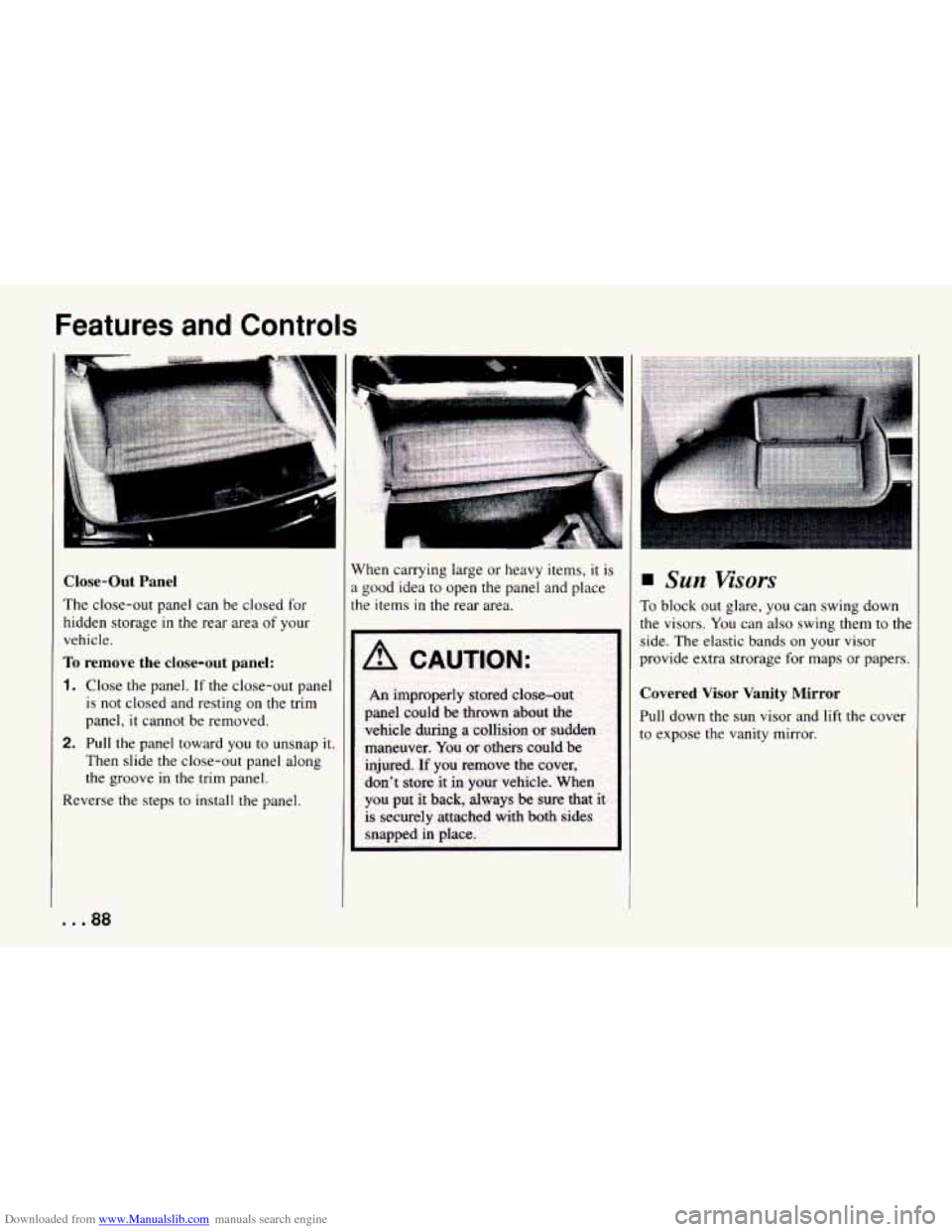
Downloaded from www.Manualslib.com manuals search engine Features and Controls
Close-Out Panel
The close-out panel can be closed for
hidden storage
in the rear area of your
vehicle.
To remove the close-out panel:
1. Close the panel. If the close-out panel
is not closed and resting on the trim
panel, it cannot be removed.
2. Pull the panel toward you to unsnap it.
Then slide the close-out panel along
the groove
in the trim panel.
Reverse the steps to install the panel.
a
When carrying large or heavy items, it is
a good idea to open the panel and place
the items
in the rear area.
Sun Visors
To block out glare, you can swing down
the visors. You can also swing them to the
side. The elastic bands on your visor
provide extra strorage for maps or papers.
Covered Visor Vanity Mirror
Pull down the sun visor and lift the cover
to expose the vanity mirror.
. ..%a
Page 134 of 292
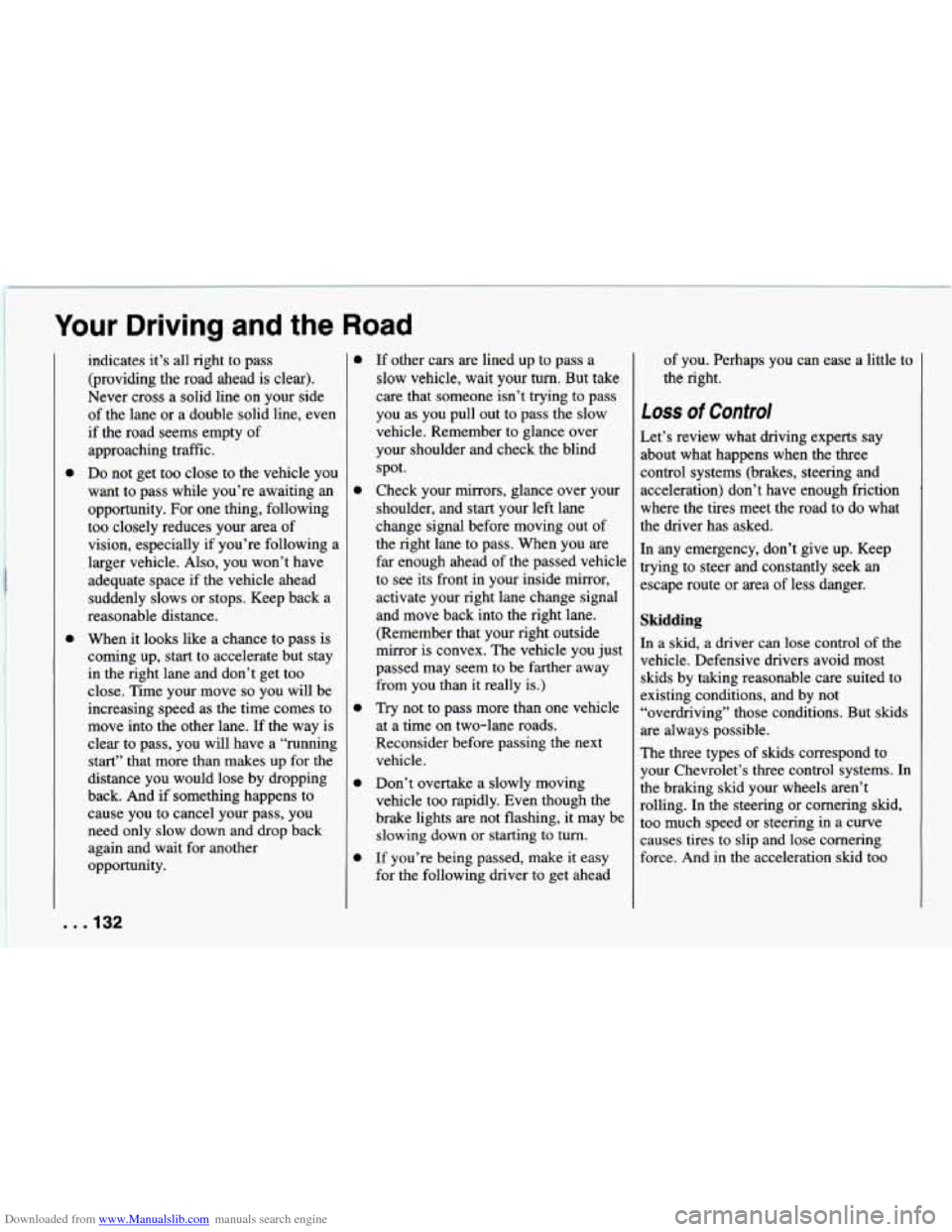
Downloaded from www.Manualslib.com manuals search engine Your Driving and the Road
a
a
indicates it’s all right to pass
(providing the road ahead is clear).
Never cross a solid line on your side
of the lane or a double solid line, even
if the road seems empty of
approaching traffic.
Do not get too close to the vehicle you
want to pass while you’re awaiting an
opportunity. For one thing, following
too closely reduces your area of
vision, especially if you’re following a
larger vehicle. Also, you won’t have
adequate space if the vehicle ahead
suddenly slows or stops. Keep back a
reasonable distance.
When it looks like a chance to pass is
coming up, start to accelerate but stay
in the right lane and don’t get too
close. Time your move
so you will be
increasing speed as the time comes to
move into the other lane. If the way is
clear to pass, you will have a “running
start” that more than makes up for the
distance you would lose by dropping
back. And
if something happens to
cause you to cancel your pass, you
need only slow down and drop back
again and wait for another
opportunity.
0
a
a
a
If other cars are lined up to pass a
slow vehicle, wait
your turn. But take
care that someone isn’t trying to pass
you as you pull out to pass the slow
vehicle. Remember to glance over
your shoulder and check the blind
spot.
Check your mirrors, glance over your
shoulder, and start your left lane
change signal before moving out of
the right lane to pass. When you are
far enough ahead of the passed vehicle
to see its front in your inside mirror,
activate your right lane change signal
and move back into the right lane.
(Remember that your right outside
mirror is convex. The vehicle you just
passed may seem to be farther away
from you than it really is.)
Try not to pass more than one vehicle
at a time on two-lane roads.
Reconsider before passing the next
vehicle.
Don’t overtake a slowly moving
vehicle too rapidly. Even though the
brake lights are not flashing, it may be
slowing down
or starting to turn.
If you’re being passed, make it easy
for the following driver to get ahead
of you. Perhaps you can ease a little to
the right.
loss of Control
Let’s review what driving experts say
about what happens when the three
control systems (brakes, steering and
acceleration) don’t have enough friction
where the tires meet the road to do what
the driver has asked.
In any emergency, don’t give up. Keep
trying to steer and constantly seek an
escape route or area of less danger.
Skidding
In a skid, a driver can lose control of the
vehicle. Defensive drivers avoid most
skids by taking reasonable care suited to
existing conditions, and by not
“overdriving” those conditions. But skids
are always possible.
The three types of skids correspond to
your Chevrolet’s three control systems. In
the brakmg skid your wheels aren’t
rolling. In the steering or cornering skid,
too much speed or steering in a curve
causes tires to slip and lose cornering
force. And in the acceleration skid too
. . .132
Page 135 of 292
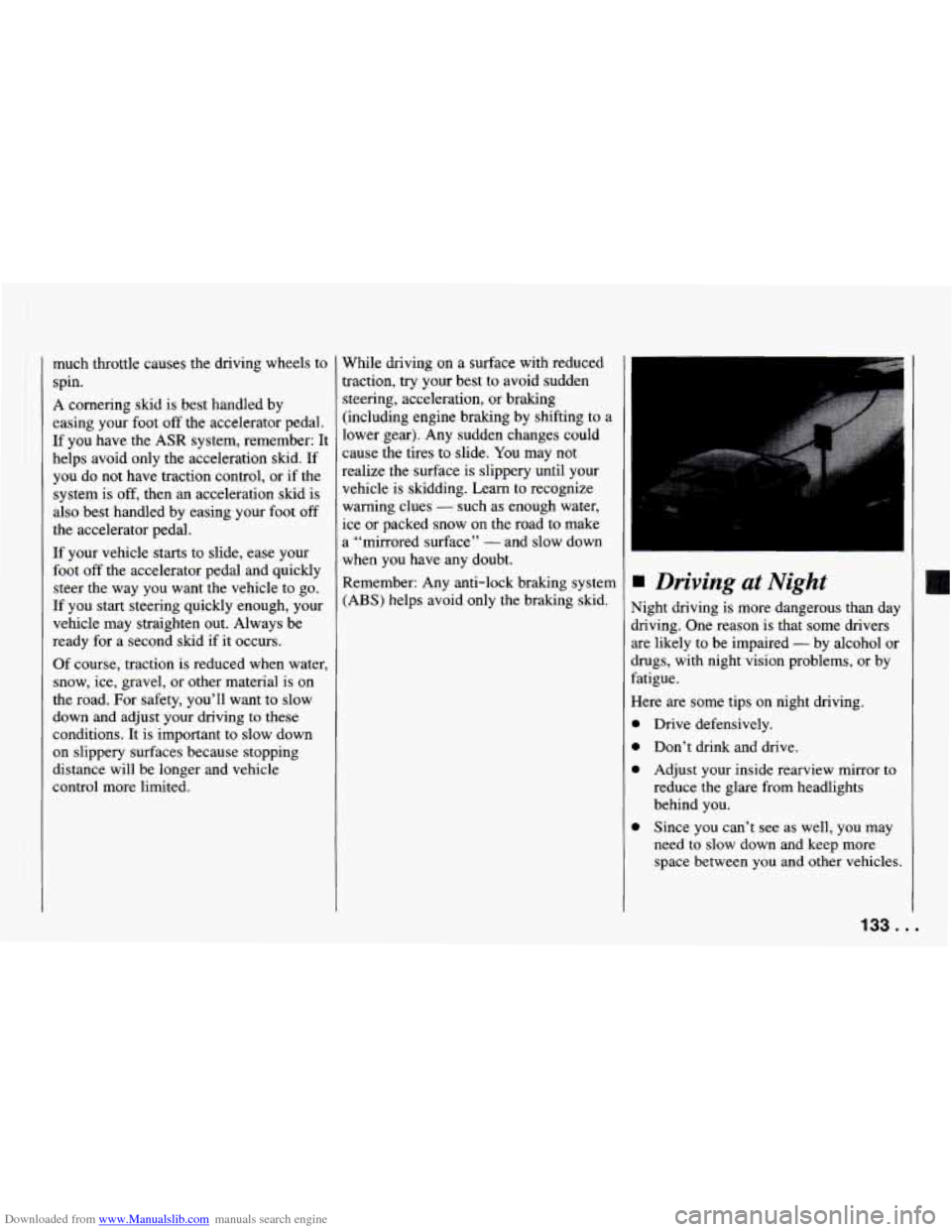
Downloaded from www.Manualslib.com manuals search engine much throttle causes the driving wheels to
spin.
A cornering skid is best handled by
easing your foot
off the accelerator pedal.
If you have the ASR system, remember: It
helps avoid only the acceleration skid. If
you do not have traction control, or
if the
system is
off, then an acceleration skid is
also best handled by easing your foot
off
the accelerator pedal.
If your vehicle starts to slide, ease your
foot
off the accelerator pedal and quickly
steer the way you want the vehicle to go.
If you start steering quickly enough, your
vehicle may straighten out. Always be
ready for a second skid if it occurs.
Of course, traction is reduced when water,
snow, ice, gravel, or other material is on
the road. For safety, you’ll want to slow
down and adjust your driving
to these
conditions. It is important to slow down
on slippery surfaces because stopping distance will be longer and vehicle
control more limited. While
driving on a surface with reduced
traction, try
your best to avoid sudden
steering, acceleration,
or braking
(including engine bralung by shifting to a
lower gear). Any sudden changes could
cause the tires to slide. You may not
realize the surface is slippery until your
vehicle is skidding. Learn to recognize
warning clues
- such as enough water,
ice or packed snow on the road to make
a .“mirrored surface”
- and slow down
when you have any doubt.
Remember: Any anti-lock braking system
(ABS) helps avoid only the braking skid.
. ..
I
4
Driving at Night
\Tight driving is more dangerous than day
hiving. One reason is that some drivers
tre likely to be impaired
- by alcohol or
lrugs, with night vision problems, or by
atigue.
lere
are some tips on night driving.
Drive defensively.
Don’t drink and drive.
Adjust your inside rearview mirror to
reduce the glare from headlights
behind you.
Since you can’t see as well, you may
need to slow down and keep more
space between
you and other vehicles.
133 ...
Page 139 of 292
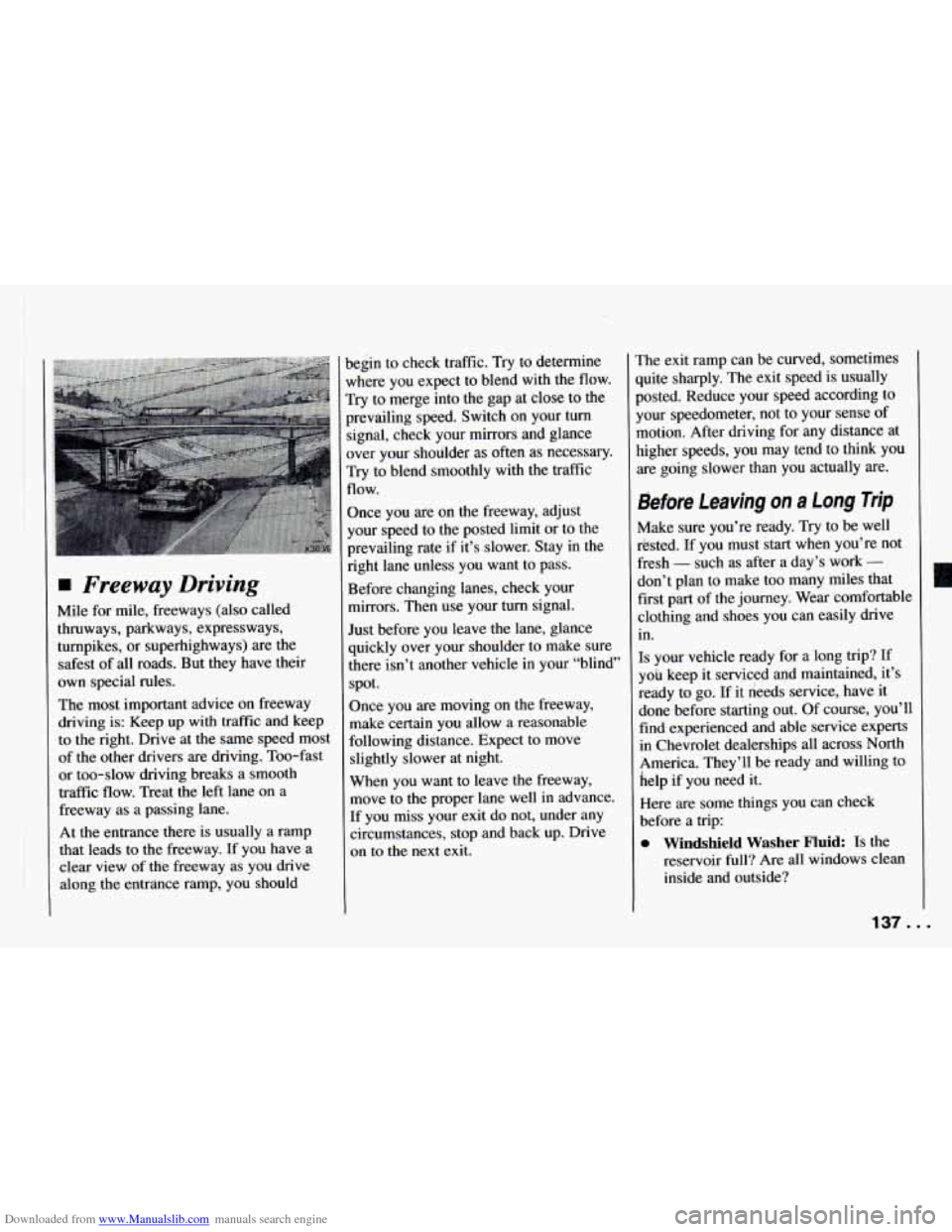
Downloaded from www.Manualslib.com manuals search engine Freeway Driving
Mile for mile, freeways (also called
thruways, parkways, expressways, turnpikes, or superhighways) are the
safest of all roads. But
they have their
own special rules.
The most important advice
on freeway
driving is: Keep up with traffic and keep
to the right. Drive at the same speed most
of the other drivers are driving. Too-fast
or too-slow driving breaks a smooth
traffic flow. Treat the left lane
on a
freeway as a passing lane.
At the entrance there is usually a ramp
that leads
to the freeway. If you have a
clear view of
tHe freeway as you drive
along the entrdnce ramp, you should 3egin
to check traffic. Try to determine
where
you expect to blend with the flow.
Try to merge into the gap at close to the
prevailing speed. Switch on your
turn
signal, check your mirrors and glance
wer your shoulder
as often as necessary.
Iiy to blend smoothly with the traffic
flow.
Once you are
on the freeway, adjust
your speed to the posted limit or
to the
prevailing rate
if it’s slower. Stay in the
right lane unless you want to pass.
Before changing lanes, check your
mirrors. Then use your turn signal.
Just before you leave the lane, glance
quickly over your shoulder to make sure
there isn’t another vehicle in your “blind”
spot.
Once you are moving on the freeway,
make certain you allow a reasonable
following distance. Expect to move
slightly slower at night.
When
you want to leave the freeway,
move to the proper lane well in advance.
If you miss your exit do
not, under any
circumstances, stop and back up. Drive
on
to the next exit. The
exit ramp can be curved, sometimes
luite sharply. The exit speed is usually
losted. Reduce your speed according to
lour speedometer, not to your sense
of
notion. After driving for any distance at
ligher speeds,
you may tend to think you
we going slower than
you actually are.
Before Leaving on a Long Trip
Make sure you’re i-eady. Try to be well
hted.
If you must start when you’re not
iresh
- such as after a day’s work -
jon’t plan to make too many miles that
first part of the journey. Wear comfortable
zlothing and shoes you can easily drive
Ln.
[s your vehicle ready for a long trip? If
yob keep it serviced and maintained, it’s
ready to
go. If it needs service, have it
done before starting out. Of course, you’ll
find experienced and able service experts
in Chevrolet dealerships all across North
America. They’ll be ready and willing to
help if you need it.
Here are some things you can check
before a trip:
0 Windshield Washer Fluid: Is the
reservoir full? Are all windows clean
inside and outside?
Page 140 of 292
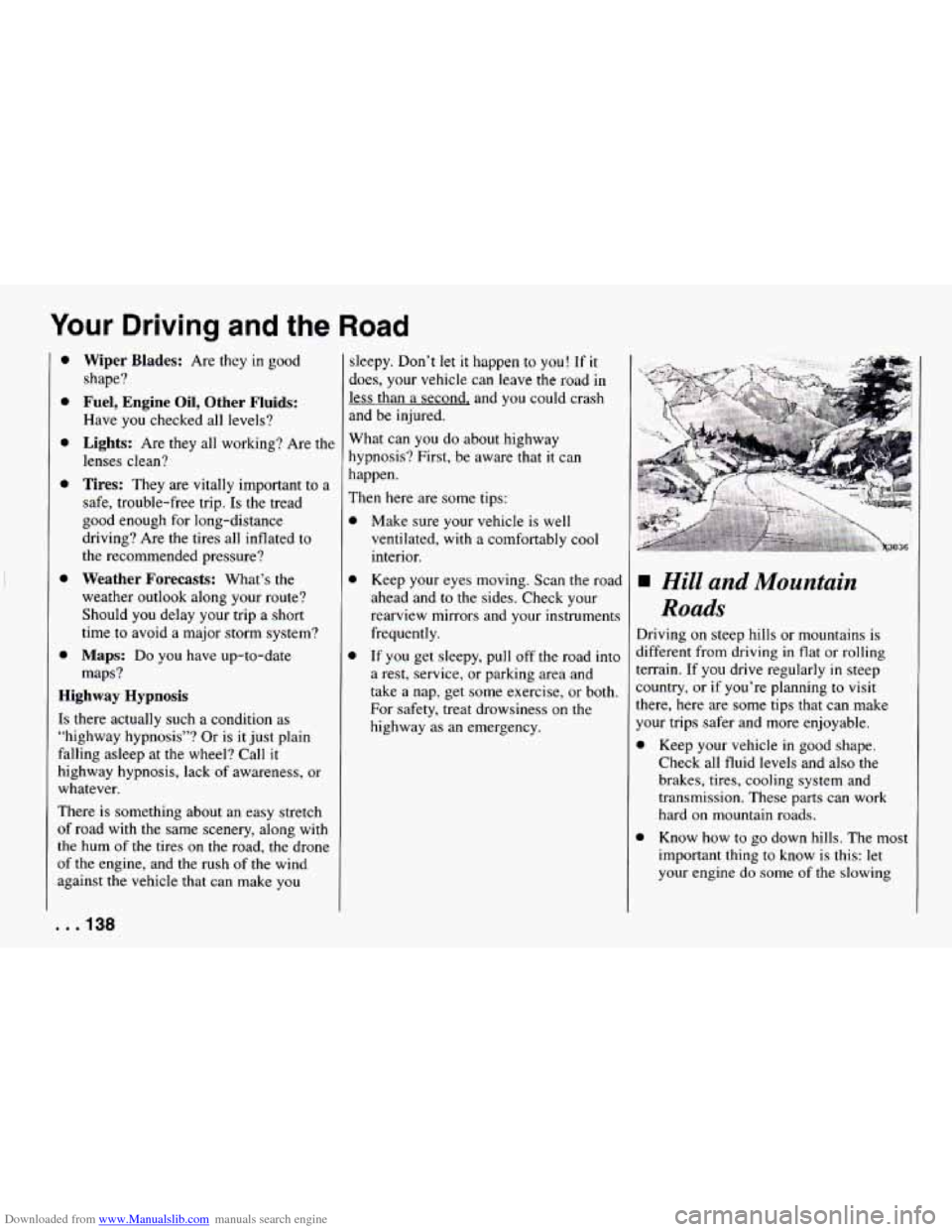
Downloaded from www.Manualslib.com manuals search engine Your Driving and the Road
e
e
Wiper Blades: Are they in good
shape?
Fuel, Engine Oil, Other Fluids:
Have you checked all levels?
Lights: Are they all working? Are the
lenses clean?
Tires: They are vitally important to a
safe, trouble-free trip. Is the tread
good enough for long-distance
driving? Are the tires all inflated to
the recommended pressure?
Weather Forecasts: What’s the
weather outlook along your route?
Should you delay your trip a short
time to avoid a major
storm system?
Maps: Do you have up-to-date
maps?
Highway Hypnosis
Is there actually such a condition as
“highway hypnosis”? Or is it just plain
falling asleep at the wheel? Call
it
highway hypnosis, lack of awareness, or
whatever.
There is something about an easy stretch
of road with the same scenery, along with
the hum of the tires
on the road, the drone
of the engine, and the rush
of the wind
against the vehicle that can make you sleepy. Don’t
let it happen to
you! If it
does, your vehicle can leave the road in
less than a second, and you could crash
and be injured.
What can you do about highway
hypnosis? First, be aware that
it can
happen.
Then here are some tips:
Make sure your vehicle is well
ventilated,
with a comfortably cool
interior.
Keep your eyes moving. Scan the road
ahead and
to the sides. Check your
rearview mirrors and your instruments
frequently.
If you get sleepy, pull
off the road into
a rest, service, or parking area and
take
a nap, get some exercise, or both.
For safety, treat drowsiness on the
highway as an emergency.
Hill and Mountain
Roads
Driving on steep hills or mountains is
different from driving
in flat or rolling
terrain.
If you drive regularly in steep
:ountry, or
if you’re planning to visit
there, here are some tips that can make
your trips safer and more enjoyable.
Keep your vehicle
in good shape.
Check all fluid levels and also the
brakes, tires, cooling system and
transmission. These parts can work
hard on mountain roads.
Know how to go down hills. The most
important thing
to know is this: let
your engine do some of the slowing
. . .13%
Page 147 of 292
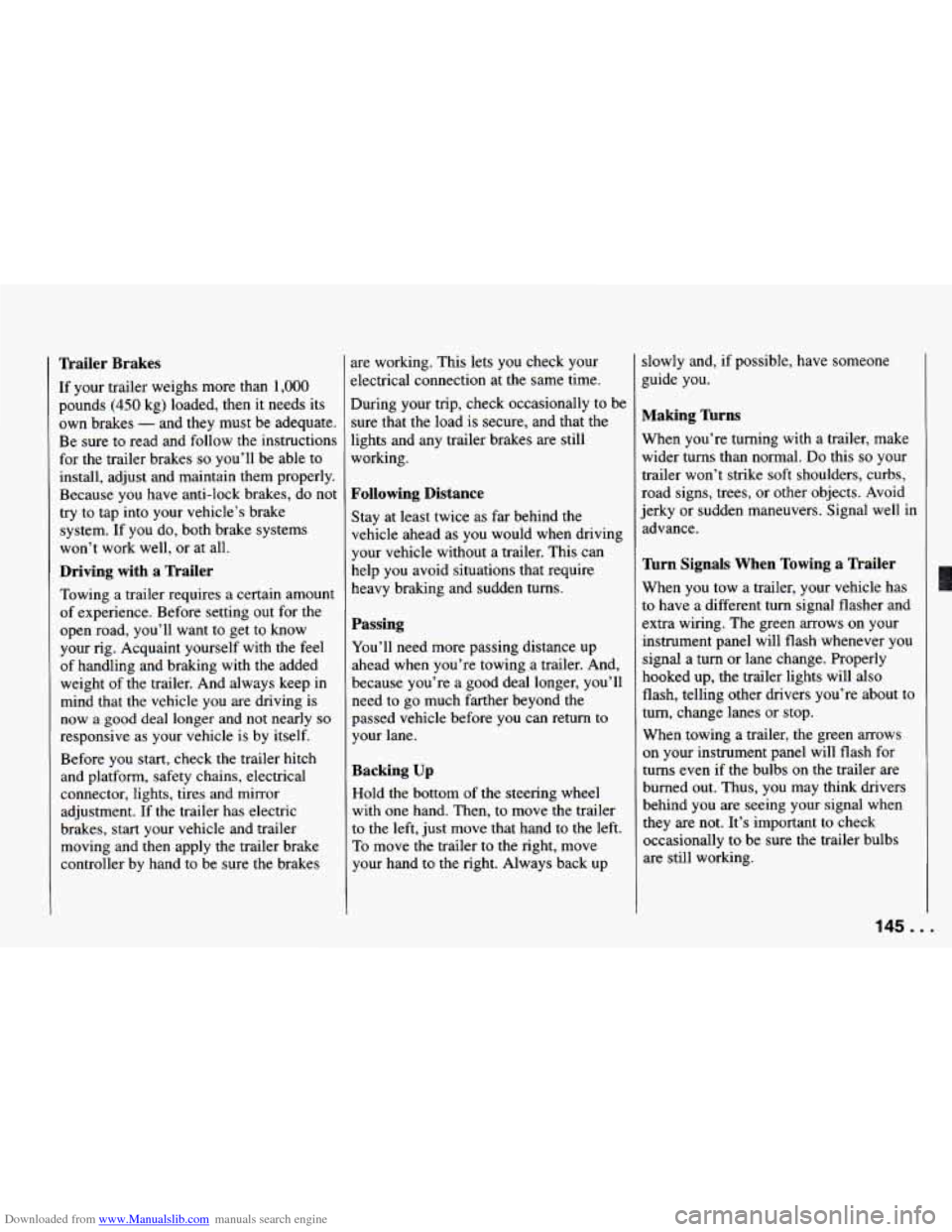
Downloaded from www.Manualslib.com manuals search engine Trailer Brakes
If your trailer weighs more than 1,000
pounds (450 kg) loaded, then it needs its
own brakes
- and they must be adequate.
Be sure to read and follow the instructions
for the trailer brakes
so you’ll be able to
install, adjust and maintain them properly.
Because you have anti-lock brakes, do not
try to tap into your vehicle’s brake
system. If you do, both brake systems
won’t work well, or at all.
Driving with a Trailer
Towing a trailer requires a certain amount
of experience. Before setting out for the
open road, you’ll want to get to know
your rig. Acquaint yourself with the feel
of handling and braking with the added
weight of the trailer. And always keep in
mind that the vehicle you are driving is
now
a good deal longer and not nearly so
responsive as your vehicle is by itself.
Before you start, check the trailer hitch
and platform, safety chains, electrical
connector, lights, tires and mirror
adjustment. If the trailer has electric
brakes, start your vehicle and trailer
moving and then apply the trailer brake
controller by hand to be sure
the brakes are working.
This lets
you check your
electrical connection at the same time.
During your trip, check occasionally to be sure that the load is secure, and that
the
lights and any trailer brakes are still
working.
Following Distance
Stay at least twice as far behind the
vehicle ahead as you would when driving
your vehicle without a trailer. This can
help you avoid situations that require
heavy braking and sudden turns.
Passing
You’ll need more passing distance up
ahead when you’re towing a trailer. And,
because you’re a good deal longer, you’ll need to go much farther beyond the
passed vehicle before you can return
to
your lane.
Backing Up
Hold the bottom of the steering wheel
with one hand. Then, to move the trailer
to the left, just move that hand to the left.
To move the trailer to the right, move
your hand to the right. Always back up slowly
and, if possible, have someone
guide you.
Making Turns
When you’re turning with a trailer, make
wider turns than normal.
Do this so your
trailer won’t strike soft shoulders, curbs,
road signs, trees, or other objects. Avoid
jerky or sudden maneuvers. Signal well in
advance.
Turn Signals When Towing a Trailer
When you tow a trailer, your vehicle has
to have a different turn signal flasher and
extra wiring. The green arrows on your
instrument panel will flash whenever you
signal a turn or lane change. Properly
hooked up, the trailer lights will also
flash, telling other drivers you’re about to
turn, change lanes or stop.
When towing a trailer, the green arrows
Dn your instrument panel will flash for
turns even if the bulbs on the trailer are
burned out. Thus, you may think drivers
behind you
are seeing your signal when
they are not. It’s important to check
occasionally to be sure the trailer bulbs
are still working.
145. I